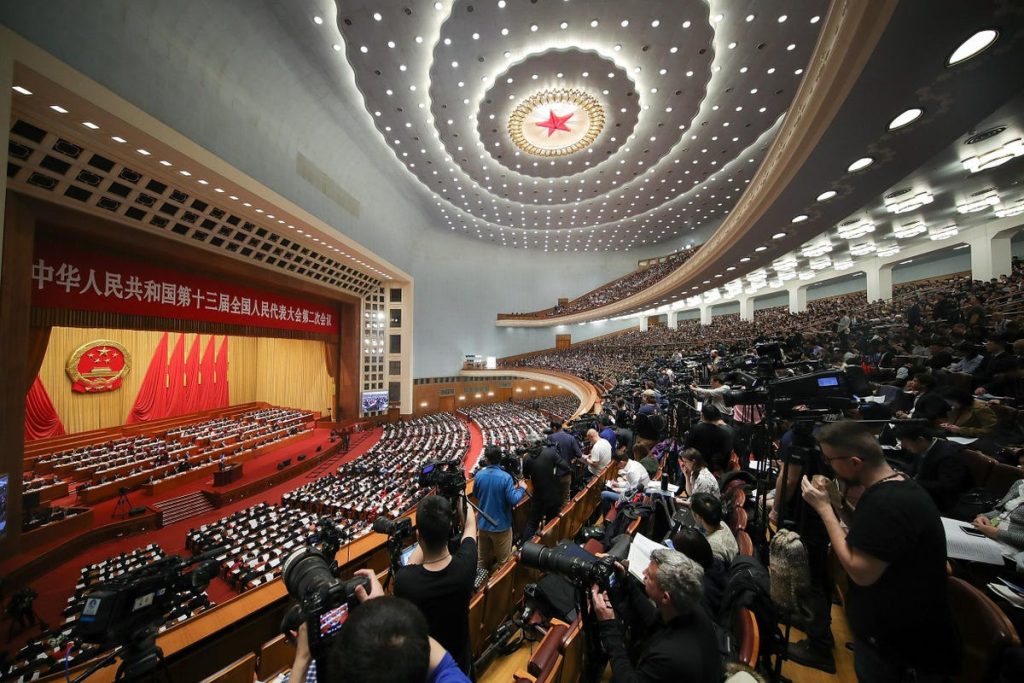At the recent meetings of its National People’s Congress and Chinese People’s Political Consultative Conference, known as the two sessions, China made important changes to its financial and technology regulations to address significant challenges at home and overseas. Beijing is intent on ensuring financial stability at home and achieving breakthroughs in so-called “chokepoint technologies” as it deals with an increasingly fraught relationship with the United States.
One lingering question remains though: Will China’s dynamic private sector be sufficiently empowered by the reforms?
Beefing Up Financial Oversight
There were several major changes to China’s financial regulatory regime announced at the NPC: The China Banking and Insurance Regulatory Commission will be retired and replaced by a new regulatory body called the National Financial Regulatory Administration (NFRA
NFRA
), while the China Securities Regulatory Commission (CSRC) will be elevated to become a government agency directly under the State Council.
The NFRA will take over some of the People’s Bank of China’s (PBOC) regulatory responsibilities, such as oversight of fintechs and state-owned financial firms, as well as the CSRC’s consumer protection work.
It is no surprise that Beijing is making changes to the core financial regulatory system that will allow it to keep a more watchful eye on fintechs. Without adequate regulation of this fast-growing segment of financial services, China has resorted to sporadic crackdowns, first on cryptocurrency, then on peer-to-peer lending, and finally on fintech giants like Ant Group. In theory, the new regulatory body will be able to supervise these companies more effectively than the PBOC – which has many other important responsibilities.
The CSRC’s new responsibilities will include review of corporate bond issuance, which will give the agency a larger role in local government bond issuance. This is for the best: Local government debt in China has reached astronomical levels, necessitating tighter oversight. Overall local government debt in China is US$9 trillion, according to Reuters. Local Government Financing Vehicles (LGFVs) have US$790 billion worth of onshore bonds coming due this year, according to Fitch Ratings.
Meanwhile, the People’s Bank of China (PBOC) will also be restructured. The Chinese central bank will replace its eight regional branches with provincial-level branches. Further, its county-level subbranches will be closed, and their functions transferred to prefectural-level offices.
One way to think about these reforms is as an effort to bring China’s financial regulatory regime more in line with international standards, with the PBoC focusing on monetary policy and macroprudential supervision like the central banks of most major economies, and the NFRA overseeing compliance and risk management in the financial sector, as well as investor protection.
Self-reliance In Technology
While its financial reforms are primarily aimed at domestic challenges, China’s technology regulatory changes are a response to U.S. sanctions that aim to kneecap its progress in sectors like semiconductors, artificial intelligence and defense & aerospace. The U.S. has put more than 600 Chinese firms in these industries on a trade blacklist that bans them from accessing U.S. technology and components without Washington’s approval.
The U.S. and China have long been at loggerheads over China’s trade practices, which Washington considers unfair, and were unable to resolve their differences with the phase 1 trade deal signed in January 2020. Chief among the U.S.’s concerns is China’s policy of civil-military fusion, which can make it difficult to determine if certain American technologies will be used for normal commercial purposes or by the Chinese military.
Now largely cut off from advanced foreign semiconductor technology, China believes it has no choice but to focus on self-sufficiency. It is against this backdrop that Beijing has ordered the Ministry of Science and Technology (MOST) to create a new Communist Party committee to directly oversee science and technology. This committee will answer directly to Xi Jinping and be charged with making technological breakthroughs in so-called “chokepoint technologies.” Additionally, MOST will be streamlined and longer participate in the review and management of certain scientific research projects.
There are also practical reasons for shifting to a highly centralized approach. Since 2015, China has spent a staggering US$150 billion on developing its domestic semiconductor industry, but the results have been decidedly mixed. Given the decentralized nature of the policy, investment has sometimes been misdirected as local governments competed fiercely for government funding.
Private Sector Prowess
While there is no doubt about the Chinese leadership’s commitment to regulatory reform in finance and technology, the reforms will not come to full fruition if the private sector is not allowed sufficient room to thrive. This applies to both finance and the hard technologies that Beijing is focused on mastering.
In the case of financial services, China’s pace of innovation has slowed dramatically from the mid-2010s when it was the undisputed global leader in digital financial technology. The reason is that the central government has used a heavy hand to control systemic financial risk as well as curb the power of certain oligopolies.
Facing growing economic challenges, China cannot rely on the state’s leadership alone. Yet it remains unclear if the private sector will be let off its short leash. Earlier this month, state radio quoted Xi Jinping as saying to private firms, “Be rich and responsible, be rich and benefit others, be rich and loving.”
An important bellwether for the Chinese fintech sector’s future prospects will be the progress of Ant Group’s long-delayed IPO. Now that Jack Ma has given up control of Ant, Beijing may finally give its blessing for the IPO. But as of January, the company said it had no plans to go public.
Ant’s valuation has fallen from US$235 billion just before the abortive IPO to US$64 billion as of January.
The completion of the Ant deal – which will still be a blockbuster, if diminished considerably from its original record-breaking US$34 billion – will signal that at last the tech crackdown is over, and that China’s fintech sector can breathe a little more easily.
For now though, we’re all still waiting with somewhat bated breath.
Read the full article here



